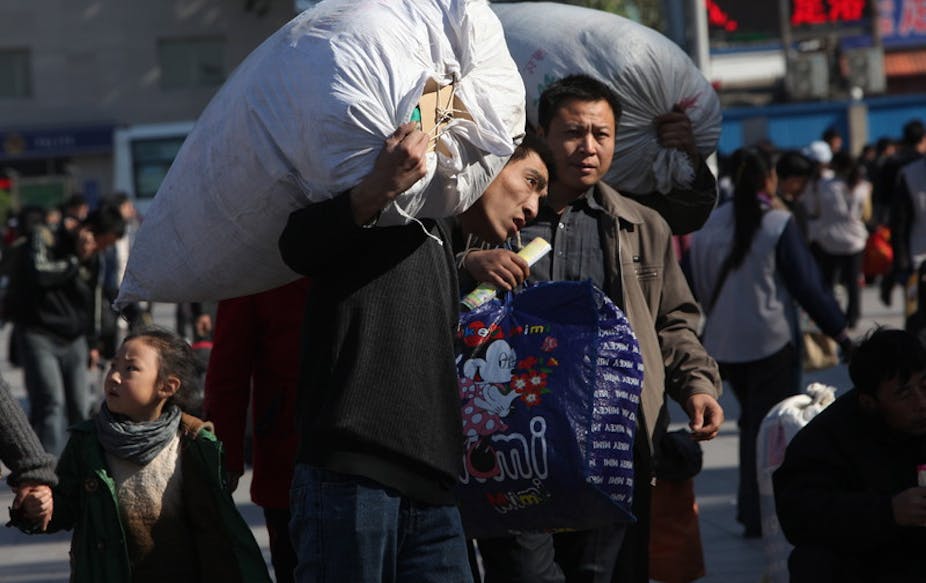Mass migration is a huge issue in China’s fast-growing cities, deepening existing anxieties about urban sprawl, the overheated real estate markets, overcrowding, land disputes, and social unrest. On a recent visit to Beijing, I explored two parts of the city that were composed of migrants: a gated community I call “capital retreat” in Shunyi on the NE edge of the city, popular with UK and other foreign migrants, and Xiao Jiahe, an area based on the north-western edge of the city that housed poor internal migrants.
These two groups lead very different lives in their two very different neighbourhoods, but both are the product of China’s spectacular economic growth and the myriad opportunities it generates for migrants.
With 4,000 “original” residents and 40,000 internal migrants, Xiao Jiahe struggles to accommodate its new migrants. Its roads and transport connections, proximity to Beijing’s highest concentration of IT companies, and cost of living make it a popular city portal for internal migrants.
Work is a key motivator in all migration journeys. Locating work, moving closer to it, transporting old work skills to new places, adapting them to new circumstances, and learning new skills that fit better in new places – these are the principal tasks that economic migrants face. All migrants sometimes ride on the navigational skills of others: “chains” of migrants make their way and help others with jobs, accommodation and contacts in the city. Knowledge circulates as people learn how to navigate the city, and the interpersonal politics of offering and accepting practical support.
Speaking to one migrant, Shi Shouyun, my co-investigators and I began to see that internal migrants experience Beijing as a city constantly being torn down and remade. They live on intimate terms with urban renewal. Shouyun said: “My first shop was in Hai Dian in 2004. This area has been demolished. The building was destroyed and reconstructed, so I moved shop four times.”
Shouyun’s sees the city as a platform in the migrant political economy, born of the tension between the price of rent and other daily necessities on the one hand and the profit margins of migrant service-sector businesses on the other. In essence, the disposable incomes of marginally and casually employed migrants determine other migrants’ profit margins.
Internal migrants like Shouyun know how to act. They learn new strategies for urban survival, and have intimate knowledge of the ways in which Beijing works through their navigation of it. They have a sophisticated grasp of what the city is and can be. They navigate it – and fabricate it – with imagination and skill.
Forbidding city
Developments like “Capital Retreat” in Shunyi house the “simply rich” owners of private businesses, Chinese ex-cadres who made their tunes in privatisation along with foreign migrants. Beijing absorbs the newly rich: it facilitates their consumption of housing, leisure activities, upmarket dining and shopping malls, just as it absorbs those who must dance with the bulldozers in order to get by.
Gated communities enforce social exclusion and urban segregation through various forms of security, and the notion of a gated community is widely associated with fear and demand for security in an uncertain world – or, as is apparent in the case of British migrants, an indecipherable one.
Work skills are a key navigation tool for the British migrants in Capital Retreat too. But unlike internal migrants, these people rarely need to develop new skills; they work as teachers in the UK, and do the same in Beijing. This contrasts with the myriad changes in occupation that internal migrants go through, and the intimate terms on which they have to live with their emerging city.
The British migrants in Capital Retreat know that their neighbourhood is not the “real” Beijing. They know that they live at a considerable distance from the Chinese fabric of the city, more than 10km from the city centre. They understand that they are separated from the city by social and cultural gaps they find impossible to bridge.
British migrants are multiply disconnected from the city. In addition to being spatially disconnected, they rely on Chinese interlocutors to translate and operate the city for them. As Jessica, who lives in Capital Retreat, said: “It’s not real life because I will never be Chinese. I would never actually be accepted into the Chinese community, I would always be an oddity. I’m a Westerner, a foreigner.”
Internal migrants demonstrate adaptability, imagination, inventiveness, collaboration and improvisation; with these skills, they maintain fragile footings in cities they are constantly having to re-navigate. Compare this to the UK migrants in Beijing, who on the whole repeat what they know in work, lifestyles and language, extending in only limited ways their capacities and repertoires in response to the challenges of the city.
What the two different migrant experiences have shown me is that migration scholars and commentators need to rethink their often static conceptions of skill, and the ways it’s connected with formal qualifications and labour markets. They also need to take cities seriously as places where migration is enacted in daily routines and journeys. Instead, a conception is needed that speaks to a world on the move, and the skills that constitute the substance of migration: movement and navigation.

